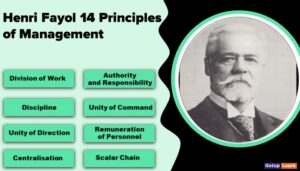Table of Contents
What is Human Relation Approach?
The Human Behavioural approach is a modified version of the Human Relations approach. The Human Behavioural approach is devoid of any emotional content, which is the core of the Human Relations Approach. This approach stresses the individual performing the job. Here the attention is directed towards the human aspects of management.
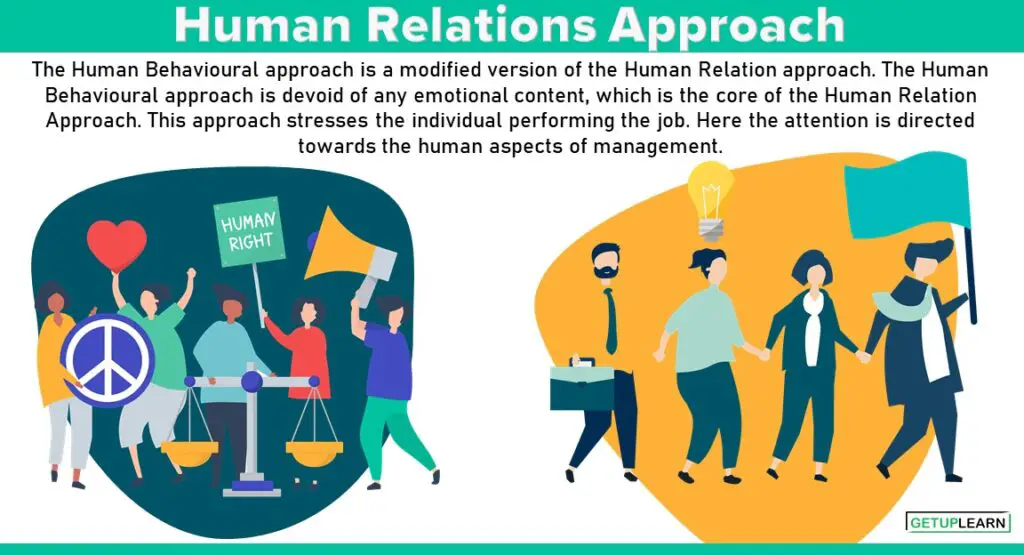
The neglect of human factors and the over-emphasis on machines and materials led to the development of this approach. The Behavioural approach emphasizes the synchronization of group goals within the broader framework of management. It does not consider the goals of the different groups as conflicting with others.
Many sociologists, psychologists and social psychologists have shown considerable interest in studying the problems of management. The sociologists who have contributed to management are Blak, Selznick, Homans, Dubin, Dalton, Katz and Kahn. The social psychologist who has contributed to management are McGregor, Argyris, Leavitt, Blake and Mouton, Sayles, Tannenbaum and his associates, Bennis, Fielder, Stogdill and Herzberg.
Behavioural theories have drawn heavily on the work of Maslow. Douglas McGregor built on Maslow’s work in explaining his ‘Theory X’ and ‘Theory Y’. Frederick Herzberg develops a two-factor theory of motivation. To sum up, many conclusions of the contributions made by behaviouralists can be presented as follows:
- People do not dislike work. If they have helped to establish objectives, they want to achieve them. In fact, job itself is a source of motivation and satisfaction to employees.
- Most people can exercise a great deal of self-direction and self-control than are required in their current job. Therefore, there remains untapped potential among them.
- The manager’s basic job is to use the untapped human potential in the service organization.
- The managers should create a healthy environment wherein all the subordinates contribute to the best of their capacity. The environment should provide a healthy, safe, comfortable and convenient place to work.
- The manager should provide for self-direction by subordinates and they must be encouraged to participate fully in all important matters.
- Operating efficiency can be improved by expanding subordinate influence, direction and self-control.
- Work satisfaction may improve as a by-product of subordinates making use of their potential.
Hawthorne Studies
In 1927, a group of researchers led by George Elton Mayo and Fritz J. Roethlisberger at the Harvard Business School were invited to join in the studies at the Hawthorne Works of Western Electric Company, Chicago. The experiment lasted up to 1932.
Earlier, from 1924 to 1927, the National Research Council made a study in collaboration with the Western Electric Company to determine the effect of illumination and other conditions upon workers and their productivity.
- Illumination Experiment
- Relay Assembly Room Experiment
- Bank Wiring Observation Room Experiment
- Mass Interview Programme
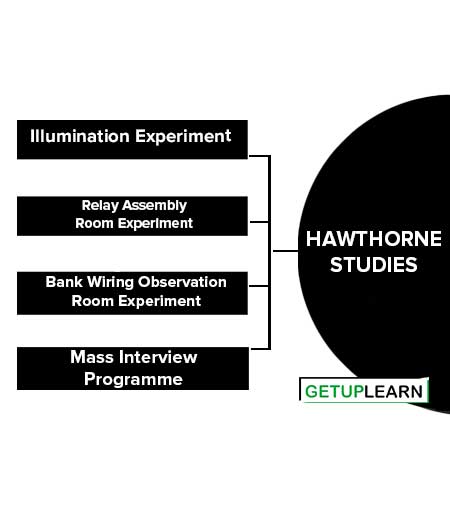
Illumination Experiment
This experiment was conducted to establish a relationship between output and illumination. The output tended to increase every time as the intensity of light was improved. But the output again showed an upward trend when the illumination was brought down gradually from the normal level.
Thus, it was found that there is no consistent relationship between the output of workers and illumination in the factory. There were some other factors which influenced the productivity of workers when the intensity of light was increased or decreased.
Relay Assembly Room Experiment
In this experiment, a small homogeneous work group of girls was constituted. Several new elements were introduced in the work atmosphere of this group. These included shorter working hours, rest pauses, improved physical conditions, friendly and informal supervision, free social interaction among group members, etc.
Productivity and morale increased considerably during the period of the experiment. Morale and productivity were maintained even if improvements in working conditions were withdrawn. The researchers concluded that socio-psychological factors such as the feeling of being important, recognition, attention, participation, cohesive workgroup, and non-directive supervision held the key to higher productivity.
Bank Wiring Observation Room Experiment
This experiment was conducted to study a group of workers under conditions which were as close as possible to normal. This group comprised 14 workers.
After the experiment, the production records of this group were compared with their earlier production records. There were no significant changes in the two because of the maintenance of ‘normal conditions’. However, the existence of informal cliques in the group and informal production norms were observed by the researchers.
The Bank Wiring Experiment led to the following observations:
- Each individual was restricting output.
- The group had its own “unofficial” standards of performance.
- Individual output remained fairly constant over a period of time.
- Departmental records were distorted due to differences between the actual and reported output or between standard and reported working time.
Mass Interview Programme
The researchers interviewed a large number of workers with regard to their opinions on work, working conditions and supervision. Initially, a direct approach was used whereby interviewers asked questions considered important by managers and researchers.
Later, this approach was replaced by an indirect technique where the interviewer simply listen to what the employees had to say. The findings confirmed the importance of social factors at work in the total work environment.
Human Relations Theory of Management
Contributions of human relations approach or Hawthorne Studies. The human relationists proposed the following points as a result of their findings of the Hawthorne experiments:
- Social System
- Social Environment
- Informal Organization
- Group Dynamics
- Informal Leader
- Communication
- Non-Economic Rewards
- Conflicts
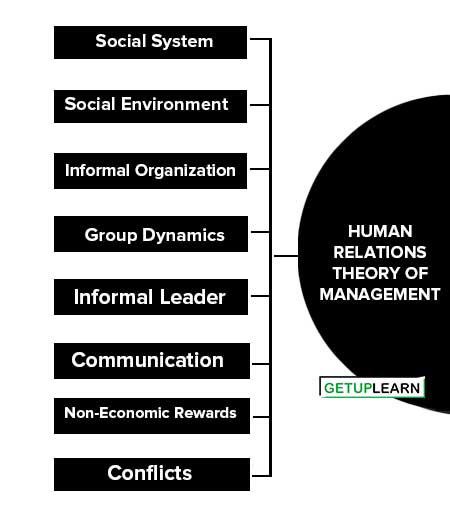
The organization in general is a social system composed of numerous interacting parts. The social system defines individual roles and establishes norms that may differ from those of the formal organization.
The social environment on the job affects the workers and is also affected by them. Management is not the only variable. Social and psychological factors exercise a great influence on the behaviour of workers. Therefore, every manager should adopt a sound human approach to all organizational problems.
Informal Organization
The informal organization does also exist within the framework of formal organization and it affects and is affected by the formal organization.
Group Dynamics
At the workplace, the workers often do not act or react as individuals but as members of groups. The group determines the norms of behaviour for the group members and thus exercises a powerful influence on the attitudes and performance of individual workers. The management should deal with workers as members of a workgroup rather than as individuals.
Informal Leader
The informal leader sets and enforces group norms. He helps the workers to function as a social group and the formal leader is rendered ineffective unless he conforms to the norms of the group.
Communication
Two-way communication is necessary because it carries necessary information downward for the proper functioning of the organization and transmits upward the feelings and sentiments of people who work in the organization. It will help in securing workers’ cooperation and participation in the decision-making process.
Workers tend to be more productive when they are given the opportunity to express their feelings, opinions and grievances. This also gives them psychological satisfaction.
Non-Economic Rewards
Money is only one of the motivators, but not the sole motivator of human behaviour. The social and psychological needs of the workers are very strong. So non-economic rewards such as praise, status, interpersonal relations, etc. play an important role in motivating employees. Such rewards must be integrated with the wages and fringe benefits of the employees.
Conflicts
There may arise conflicts between the organisational goals and group goals. Conflicts will harm the interest of workers if they are not handled properly. Conflicts can be resolved through the improvement of human relations in the organisation.
Criticism of Human Relations Approach
These are some points of criticism of the human relations approach explained below:
- Lack of Scientific Validity
- Over-Emphasis on Group
- Over-Stretching of Human Relations
- Limited Focus on Work
- Over-Stress on Socio-Psychological Factors
- Conflict Between Organizational and Individual Goals
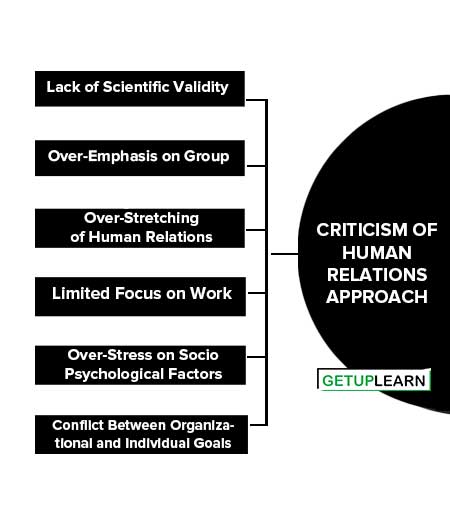
Lack of Scientific Validity
Lack of Scientific Validity: The human relationists drew conclusions from Hawthorne’s studies. These conclusions are based on clinical insight rather than on scientific evidence.
Over-Emphasis on Group
Over-emphasis on Group: The human relations approach over-emphasizes the group and group decision-making.
Over-Stretching of Human Relations
Over-stretching of Human Relations: It is assumed that all organizational problems are amenable to solutions through human relations.
Limited Focus on Work
Limited Focus on Work: The human relations approach lacks adequate focus on work.
Over-Stress on Socio-Psychological Factors
Over-stress on Socio-psychological Factors: The human relations approach undermines the role of economic incentives in motivation and gives excessive stress on social and psychological factors.
Conflict Between Organizational and Individual Goals
The conflict between Organizational and Individual Goals: It views the conflict between the goal of the organization and those of individuals as destructive.
Difference Between Human Relations and Behavioural Sciences Approach
The following are the points of difference between human relations and behavioural sciences approach:
| Human Relations Approach | Behavioural Sciences Approach |
| It laid emphasis on the individual, his needs and behaviour. | It stressed groups and group behaviour. |
| It focused on interpersonal relationships. | It focused on group relationships. |
| It was based on the Hawthorne Experiments and so its scope is limited. | It refined the Human Relations approach and has a wide scope. It is a much more systematic study of human behaviour in the organization. |
| It was pioneered by Elton Mayo and its associates. | It was pioneered by Feith Davis, Rensis Likert and others. |
| It laid emphasis on informal groups’ motivation, job satisfaction and morale. | The behaviourists studied group dynamics, informal organization leadership, motivation and participative management. |
What is the human relations approach?
The Human Behavioural approach is a modified version of the Human Relation approach. The Human Behavioural approach is devoid of any emotional content, which is the core of the Human Relation Approach.
What is the criticism of human relations approach?
The following are the criticism of human relations approach:
1. Lack of Scientific Validity
2. Over-Emphasis on Group
3. Over-Stretching of Human Relations
4. Limited Focus on Work
5. Over-Stress on Socio-Psychological Factors
6. Conflict Between Organizational and Individual Goals.














